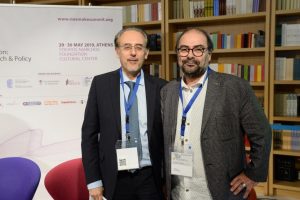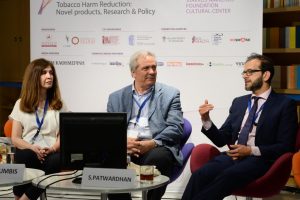Broad international participation at the 2nd Scientific Summit on Tobacco Harm Reduction in Athens
The 2nd Scientific Summit on Tobacco Harm Reduction on novel tobacco products, research and policy concluded on May 30, 2019 with participation of 32 distinguished speakers and 142 participants from 20 countries (Belgium, Bulgaria, Chile, Croatia, Cyprus, Ecuador, France, Iceland, Ireland, Germany, Greece, Latvia, Romania, Sweden, Switzerland, South Africa, Turkey, UK, Ukraine, USA).
The Scientific Summit was organised for the second year by the Department of Biochemistry-Biotechnology, Postgraduate Program “Toxicology” of the University of Thessaly, and the Laboratory of Molecular Biology and Immunology, Department of Pharmacy of the University of Patras. The collaboration of the Department of Public Health, National School of Public Health, Athens, and the 2nd Cardiology Dept., University Hospital Attikon, Medical School, National and Kapodistrian University of Athens are important additions to the organisation and enhance the conference scientific status.
Participants and speakers from 24 different organisations (university hospitals, departments, laboratories, research institutes, scientific societies etc.) gathered in Athens at the Stavros Niarchos Cultural Centre for the 2nd Scientific Summit to discuss about tobacco harm reduction. Productive debate on emerging policies and bioethics as well as research data on novel products was the core of the two-day summit that comprised 10 sessions –panel discussions, keynote speeches, and 24 abstracts, oral or poster, were presented.
Epidemiology & Prevention of Smoking: Where do we stand?
In the Summit’s opening session chaired by Mina Gaga, Pulmonologist, ex-President of the ERS, Adamantia Liapikou, Pulmonologist presented epidemiological data and data on the burden of tobacco globally and in Greece. WHO data shows a global decline in smoking prevalence, mostly in high-income countries; however, the total number of smokers is globally increasing. The prevalence of smoking in Greece is the highest prevalence in Europe and reaches 37%. A study on the association of e-cigarette use and smoking cessation in Attica, presented by Professor of Public Health, Anastasia Barbouni from the Greek National School of Public Health. According to the study, 5% of the population of Attica used an electronic cigarette and daily use of an electronic cigarette was found to increase the likelihood of smoking cessation.
Dr Lion Shahab, Associate Professor in Health Psychology, UCL presented data on adolescent e-cigarette use in the US and UK suggesting that its effect on conventional cigarette smoking uptake is negligible, contrary to the theory that e-cig use is a “gateway to smoking”. With respect to health policy he suggested EU member states, including Greece, should endorse e-cigarettes as an effective harm reduction tool for adults but restrict advertising/selling of e-cigarettes to adolescents as cool lifestyle choice.
Tobacco Control
Elias Tsougos, Cardiologist & Paraskevi Katsaounou, Pulmonologist, both experts on the subject, moderated the discussion in the Tobacco Control – Smoking Cessation session. MDs specialized in smoking cessation presented their approaches in the management of various patient categories. Kallirrhoe Kourea, Cardiologist, elaborated on organizational issues, the operation of a smoking cessation clinic, the role of health professionals, the referral system, and a comprehensive ‘quit plan’. Georgios Goumas, Cardiologist, focused on cardiovascular patients and pointed out that hospitalization following an acute cardiovascular event provides a solid opportunity for smoking cessation intervention to start in the hospital. He also pointed out that due to the recognised high risk of relapse, it is significant to follow-up and monitor patients. Zafeiria Barbaressou, Pulmonologist underlined that smoking cessation is of high priority especially in respiratory patients (COPD, lung cancer, asthma and TB), as smoking is one of the main causes of respiratory diseases, but also the most preventable one. Vasiliki Giannakopoulou, Cardiologist, stressed the health professionals’ role in smoking cessation in the elderly who should be reminded of the risks linked to smoking and of the fact that quitting smoking is beneficial, even late in life. All agreed that smoking cessation medications (NRTs) are useful.
Dr Jacques Le Houezec’s, Consultant in Public Health & Smoking Cessation Specialist, keynote speech on key differences in effects and risks of nicotine vs smoke raised a vivid debate. Himself an advocate of harm reduction, he supports the use of novel tobacco products (heated tobacco products, e-cig., snus, etc.) to reduce the harm from smoking. “Combustion is the problem” he stated. In his speech, he emphasised that nicotine is not a carcinogen. It is a psychostimulant like caffeine, while tobacco smoke is a complex mixture of more than 7,000 substances, including 69 carcinogens. “The culprit is smoke, not nicotine, and is responsible of most tobacco-related diseases”, he pointed out.
Tobacco control, harm reduction and public health, and the controversy between the two strategies, was discussed in one of the Summit’s most interesting sessions. Assistant Professor of Pulmonary Medicine Paraskevi Katsaounou, stands for the European Respiratory Society’s (ERS) position on harm reduction, which in the statement of May 30th, declared that harm reduction strategy should not be used as a population-based strategy in tobacco control. Using of e-cigarettes instead of combustible cigarettes will probably reduce users’ exposure to toxicants, but a reduction in exposure to toxicants does not necessarily lead to significant reduction in harm in humans, ERS’s position paper states.
Professor Karl Fagerstrom endorsed the statement that “tobacco harm reduction works”. He presented examples of countries where harm reduction was adopted as a strategy. Sweden’s case, the European country with the lowest prevalence in smoking, shows that the use of a product of lower potential for harm such as snus had positive results; in Japan, there is an unprecedented fall in cigarette sales in the last 5 years following the introduction of alternative heat-not-burn tobacco products; in the UK cigarette smoking prevalence reached a historic low of 15.1% in 2017 associated with e-cig use as the main aid to quitting. Professor Fagerstrom also emphasized that harm reduction interventions aren’t resource demanding for healthcare systems, and that less harmful choices become available to consumers under normal market mechanisms, have been proven effective.
Karl Snæbjörnsson, MD, presented the case of Iceland, which by practicing harm reduction has the lowest mortality from smoking related diseases in Europe (approximately 100 deaths per year in 2017). Approximately 60% decrease of smoking prevalence in young people, during the period 2016-2018, was recorded with a parallel increase of alternative tobacco products. Adult smokers percentage is also falling (by 46% during 2014-2017); currently, in 16-34 year-olds 9% are snus users, 9% e-cigarette users and a mere 4.8% cigarette smokers.
Data provided by Lars Ramstrom, Institute for Tobacco Studies, Sweden, showed that Swedes are using snus as a self-administered smoking cessation aid with significantly higher success rates than in users of nicotine gum or patch. Almost a third of ex-smokers (mainly male) after uptake of snus use has quit snus as well and became tobacco-free. Sweden has Europe’s lowest level of mortality attributable to tobacco, both with regard to deaths from all causes and deaths from specific diseases for which snus has been suspected to be a major risk factor.
The strategy of harm reduction in smoking, as in other health issues, is not “paternalistic”, leaving people freedom of choice on which decision to take, commented Martin Dockrell, Tobacco Control Programme Lead, Public Health England, UK, at the Summit’s Panel Discussion on “Why is Tobacco Harm Reduction so Divisive?”. During the discussion, chaired by Konstantinos Farsalinos, Cardiologist & Michael Toumbis, Pulmonologist, another question emerged: Is Harm Reduction a moral or a scientific issue? Most attendees replied, both. Karl Fagerstrom declared that he is in favour to ban cigarettes, but not snus or e-cig, and everyone in the panel acknowledged that more studies have to be conducted on alternative tobacco products; methodology and funding of the studies should be carefully considered so that results are reliable.
Regulation and Public Health & Policy
Implementation of harm reduction strategies regarding public health was the subject of “Regulation and Public Health & Policy” session. Kostas Athanasakis, health economist, Research Fellow at National School of Public Health emphasized the need for effective anti-smoking policies. Of all available policy measures to control smoking, increases in cigarette prices seem to be the most effective. Harm reduction is a strategy that currently is also under consideration across a wide array of risk factors, including smoking. In Greece, work needs to be done in order to persuade policy makers for its efficacy, as “the realistic” policy intervention versus “the purist approach”. Michael Toumbis, Pulmonologist, presented FDA’s regulatory approach in evaluating the alternative tobacco products, as part of a comprehensive regulatory plan announced in 2017 aiming at shifting the trajectory of tobacco-related disease, and death. Accordingly, FDA vision is “of a world where combustible cigarettes would no longer create or sustain addiction – making it harder for future generations to become addicted in the first place and allowing more currently addicted smokers to quit or switch to potentially less harmful products”. FDA put in place a series of new processes for new tobacco products: Pre-Market Tobacco Application (PMTA) is the primary pathway for a new product authorization; Modified Risk Tobacco Product Application (MRTPA) is to be filed so that any health claims about relative risk compared to continuing to conventional cigarettes could be made about a product. Following a rigorous science-based review by FDA, IQOS was granted a marketing authorization in the US recently. The agency determined that authorizing it for the U.S. market is appropriate for the protection of the public health because, among several key considerations, it produces fewer or lower levels of some toxins than combustible cigarettes but this doesn’t mean that it is safe or “FDA approved”, he added. Public Health policies on smoking control in Greece –most importantly smoking ban from public areas, working places etc.– have not been thoroughly implemented, commented Dimitri Richter, Cardiologist, however, he stressed the need for the authorities to begin to assess, on the basis of rigorous scientific criteria, the less harmful alternatives under umbrella of Harm Reduction Policies endorsement. Martin Dockrell, Public Health England (PHE) analysed the Tobacco Control Plan for England. PHE has a long tradition of evidence-based tobacco harm reduction policies, supported by analysis from organisations such as the Royal College of Physicians which estimated that e-cigarettes are likely to carry at most 5% of the risk of smoked tobacco. Smoking rates are falling faster the last decade, which makes England a leader in tobacco control. Also, youth smoking continues to fall, adult smoking rates are falling rapidly, and vaping rates are stable at around 5% of adults (so rising in proportion to smokers).
Panel Discussion participants Prof Solomon Rataemane, Sefako Makgatho Health Sciences University, Pretoria, South Africa, Karl Snæbjörnsson, Karl Fagerström, Sudhanshu Patwardhan, MD, and Konstantinos Farsalinos, which was moderated by Konstantinos Poulas and Anastasia Barbouni, discussed on the priorities of public health policy and integration of innovative and traditional health policies into an effective tobacco control plan. The experts pointed out that considering the devastating health and social effects of smoking and while acknowledging the need for long-term epidemiological studies to accurately quantify the relative risk, tobacco harm reduction products could represent a viable option for smokers unwilling or unable to quit with other methods. They underlined that a regulatory framework, adopting a risk-proportionate approach could maximize benefits and minimize potential adverse public health effects.
Science – Research – Evidence
Summit’s day 2 begun with the oral presentations of scientific and research data submitted to the Scientific Committee by Greek universities teams (University of Patras, Univ. of Athens, and the National School of Public Health) and by industry research departments, such as British American Tobacco R&D Centre, Juul Labs, and PMI Science. Stavros Topouzis, Associate Professor of Pharmacology and Toxicology, University of Patras, chaired the first part of the session where data on epidemiology & social issues, biomarkers’ evaluation, preclinical evaluation, results from research on smoking cessation were presented. Moreover, during the session “Clinical Assessment and Harm Reduction”, research on smoking cessation with novel smoking products, when several other interventions have failed, was presented by Ignatios Ikonomidis, Associate Professor in Cardiology, 2nd Cardiology Department, Attikon Hospital, University of Athens. Also, Francesco Sergio, Medical Director, Philip Morris International, presented preclinical and clinical data associated with respiratory functions, which showed lower deterioration of lung function over time upon Tobacco Heating System switching, while further impairments were observed after continued cigarette smoking.
A panel of experts on Clinical practice experience on Smoking Cessation was led by Michael Toumbis, ex-president of the Hellenic Thoracic Society and former head of the largest smoking cessation clinic in “Sotiria” General Hospital, Athens, Greece and discussed on several issues from the MDs experiences: Angeliki Florou, Pulmonologist, Kallirrhoe Kourea, Cardiologist, and Vassiliki Doumou, Psychologist from Greece, and Sudhanshu Patwardhan, MD from the UK. Dr Patwardhan briefly described the high-level services for smoking cessation provided in the UK. One hundred million pounds per annum is given to the 170 local authorities to manage in contrast with the Greek situation where the smoking cessation centres are not financially supported. In Greece smoking cessation clinics operate on a voluntary basis, by the health professionals involved. Only approximately 1,000 smokers, who decide to quit smoking, visit the clinics every year, when the prevalence of smoking in Greece is the highest in Europe (37%). In the UK, services were at their best when financing was high and smoking cessation advisors best trained. Austerity measures resulted in a lower spending budget (80 million pounds) however, in 10 years UK managed to reduce prevalence 10 percentage points (from 25% to 15%). The role of primary care services was also highlighted to provide guidance to smokers and referral to smoking cessation centres as well as all the other communication channels. In the discussion with the audience on the use of e-cigarettes for smoking cessation, not adopted by the Greek Smoking Cessation Centres, Dr Toumbis raised the issue of which product to suggest when there are more than 500 brands of e-cigs with 500 ingredients. A classification as well as a regulatory framework is needed.
Professor Solomon Rataemane, Psychiatrist, Head of Department of Psychiatry Sefako Makgatho Health Sciences University, Pretoria and Advisor to the South African Ministry of Health on Mental Health and Substance Abuse, in his Keynote Lecture “The dilemma of smoking addiction in psychiatric patients” highlighted that smoking addiction is far more difficult to manage in mentally ill patients because smoking makes them feel better, by alleviating symptoms, and they also behave better. However, patients tend to do better with alternative products in comparison with conventional cigarettes. He said that more scientific evidence appears necessary to support harm reduction in smoking and to differentiate between alternative products and expressed his disagreement on the ban of financing research by tobacco industry, underlining that some of the best research in psychiatry has been financed by it. He also announced that in South Africa a “Mini Master Plan on Harm Reduction” for all drugs including tobacco will soon be published. With respect to taxation, more is needed to convince governments to differentiate since conventional & alternative cigarettes are equally taxed.
Bioethics Panel Discussion
A Panel Discussion moderated by Tina Garani-Papadatos, lawyer and Professor of Public Health Bioethics at the National School of Public Health, Athens, was dedicated on bioethics and human rights, and focused on the ethical considerations of “harm reduction” in smoking and how to maximize benefits for smokers and minimize potential harm for youth. Perspectives from different angles were presented by the panelists, Christopher Russell, psychologist, Centre for Substance Use Research, Glasgow, Lion Shahab, Associate Professor in Health Psychology at University College London, Nikos Dedes, Chair of the Greek Association of People Living with HIV from a patient’s perspective, Manolis Souvatzis, member of the board of Greek Vapers Club from a consumer’s perspective, and Emilios Negis, medical editor and journalist. All panelists shared the view that harm reduction creates conflicts and divides, and that the youth should be protected but without compromising the chance to reduce harm in the adult chronic smokers. Novel products may need long-term studies to document their long-term impact however, the fear that e-cigarettes may be the gateway to conventional smoking for the young should not allow confusion about the unprecedented harm of conventional smoking.
As a conclusion to the 2nd Summit and on the occasion of the World No Tobacco Day, May 31st, the Organising Committee drafted and signed a Declaration entitled “Quitting smoking is one of the most effective public health measures and tobacco harm reduction can supplement tobacco control”.
The Declaration has been communicated to all speakers for endorsement. Read the Declaration here










